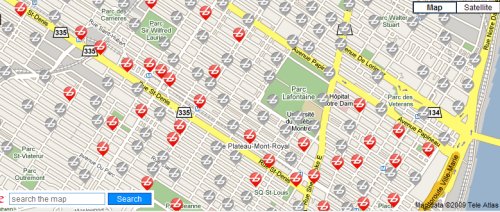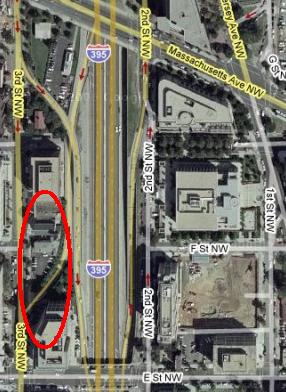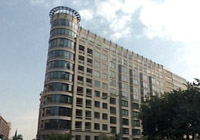|
Special Features





Image Libraries


|
|
Blog
It’s well known and frequently repeated that many state Departments of Transportation view themselves first and foremost as highway builders. Virginia is no exception, as the wealth of highway projects in the Commonwealth’s proposed capital improvement program illustrates.
The Commonwealth Transportation Board is holding a hearing on Tuesday, June 2 to discuss that plan, and is inviting public comment. At this stage the components of the plan aren’t likely to change much (at least until the next update a year from now), but since the CTB is the primary decision-making body for transportation funding in Virginia, this would be an excellent opportunity to show them that Northern Virginia is serious about multi-modalism. Perhaps as time goes by, the CTB can be convinced that transit and cycling are as important to mobility as a certain other mode.
The hearing is Tuesday, June 2 at Mary Ellen Henderson Middle School, 7130 Leesburg Pike, Falls Church, VA, near the West Falls Church Metro station. It starts at 7:00 pm. Alternatively, email comments will be accepted via Six-YearProgram (at) VDOT.Virginia (dot) gov.
Average Rating: 5 out of 5 based on 218 user reviews.
May 29th, 2009 | Permalink
Tags: government, transportation


Oh Tom Toles, I love you.
Really America, it is long past time we accepted that some things do actually need to be regulated, and that carbon is one of them. Our failure to regulate the financial industry cost us the economy. If we fail to regulate the leading cause of global climate change, we could lose more.
Average Rating: 4.6 out of 5 based on 289 user reviews.
May 27th, 2009 | Permalink
Tags: environment

This image, from GreaterGreaterWashington user Ralph, shows streetcar rails arriving at Benning Road, where DDOT will install track (but not actually start rail service) as part of its streetscape project.
For those keeping score at home, we now have tracks and streetcar vehicles, but are still years away from actually getting to ride a streetcar.

Average Rating: 4.7 out of 5 based on 235 user reviews.
May 27th, 2009 | Permalink
Tags: transportation

CommuterPageBlog reports that Montreal has launched North America’s largest bike-sharing system. Bixi cost $13 million and covers the central city of Montreal with 3, 000 bikes at 300 stations.
$13 million! You can’t build a single suburban highway interchange for that little amount of money. Montreal has just made convenient cycling available to its entire central city for pocket change, by the standards of a state DOT.
For that kind of money, there is no excuse why every city on the continent can’t have extensive public bike-sharing. If they can do it, so can we.

Bike-sharing stations in Montreal.
Average Rating: 4.9 out of 5 based on 172 user reviews.
May 22nd, 2009 | Permalink
Tags: transportation

While attending yesterday’s Urbanexus lecture by Harriet Tregoning, I listened to an exchange between Tregoning and an audience member about “design excellence” in Washington’s downtown architecture. The audience member questioned why downtown architecture isn’t better. The implication in the discussion was that Washington is a stodgy, conservative city that would be oh so much better if only it embraced contemporary here and now architecture, and if only our height limit weren’t around to constrain creativity.
But if Washington has an architecturally stodgy downtown, is it really the fault of the architectural conservatives? When I compare office buildings constructed over the last couple of decades, it seems to me we did a lot better in the 1990s, under influences that would be considered more conservative, than we’re doing now. In the 90s it didn’t matter that we had a height limit, architects found ways to make buildings interesting using crowns, distinct corners, spires, and a whole host of other traditional tricks that relied on details and ornament. If the buildings they produced weren’t exactly going to be major international landmarks, they were at least interesting and generally attractive.
But since the 90s, the world of so-called “cutting edge” architecture has more or less abandoned such ornament and adopted a more retro Meisian modernist aesthetic, resulting in the re-emergence of blank glass boxes as the high end of design. Instead of buildings like the two at top right, lately we’ve been getting more buildings like the two at bottom. Seems worse to me, not better.
Of course there are exceptions; not all the 90s buildings were as interesting as those pictured, nor are all the contemporary ones as plain (or “sleek” in the parlance of their supporters), but the question remains: How can we trust an architectural establishment to produce excellent contemporary buildings when “more contemporary” seems to be code for “more boxy”? If downtown’s architecture is stodgy, why in the world should we put our trust for recovery in with designers who want more glass curtain walls? If “faux classical” is such an awful thing, why is “faux Meisian” OK?
I’m all for a more interesting downtown, but don’t trust the modernist crowd to get us there. Not one bit.
Average Rating: 4.6 out of 5 based on 253 user reviews.
May 21st, 2009 | Permalink
Tags: architecture, featured post

|

The section of I-395 that will be capped over, with the to-be-removed off ramp circled in red. |
At yesterday’s meeting of the Transportation Planning Board, DDOT submitted paperwork necessary to move forward with the transportation-related changes to I-395 as part of the air rights development project. The project is one of the coolest in the region – it will deck over and develop the three blocks of I-395 between Massachusetts Avenue and E Street, repairing a gaping wound in the city fabric, restoring the street grid, and reconnecting the area around Union Station with the rest of downtown.
At the TPB, discussion centered around the reconfigured ingress and egress ramps. Some will be modified to accommodate the deck, but the only real significant change is that the southbound off ramp from 395 to 3rd / E Streets, NW (highlighted at right) will have to be removed. Few drivers get on the highway at New York Avenue just to exit a few blocks south at E, so even fans of urban highways can’t be too upset over the loss of that ramp.
Reconnect Union Station with downtown and remove a ginormous hole in the middle of the city at the cost of a highway ramp used by about 12 people per day? Yes please.
Average Rating: 4.6 out of 5 based on 284 user reviews.
May 21st, 2009 | Permalink
Tags: development, transportation, urbandesign

When the stimulus bill passed it included a provision for $1.5 billion in discretionary, competitive transportation grants. For the past two and a half months, transportation agencies around the country have been salivating at the thought of getting their hands on some of the dough. Ideas have come forward for a regional BRT system and a national bike-sharing program, to mention just two of many. But while there have been no shortage of ideas floated, the actual criteria for grant applications did not come out until today. Now that it’s out, agencies hoping for grants can begin serious work on applications.
Submissions are due by September 15, 2009, and all the money will be awarded no later than February 17, 2010.
Average Rating: 4.6 out of 5 based on 172 user reviews.
May 19th, 2009 | Permalink
Tags: economy, government, transportation

 Ever wondered how the circumference of the Beltway stacks up to other ring roads in cities around the world? A team from Rice University collected ring roads from 27 international cities and layered them all at the same scale in the image at right (click to enlarge). Of the cities they layered, Houston’s beltway is the largest; Washington’s is smack in the middle. Ever wondered how the circumference of the Beltway stacks up to other ring roads in cities around the world? A team from Rice University collected ring roads from 27 international cities and layered them all at the same scale in the image at right (click to enlarge). Of the cities they layered, Houston’s beltway is the largest; Washington’s is smack in the middle.
Image from Thumb Projects, first dispersed on the blogosphere by Swamplot (where in Texan fashion, they’ve mistaken “big” for “win”).
Average Rating: 4.6 out of 5 based on 153 user reviews.
May 19th, 2009 | Permalink
Tags: fun, transportation

Thanks to WashCycle for catching this nugget of a quote from an Examiner article about the dropping number of vehicle registrations in the District of Columbia:
In the District, such vehicles may be expendable. D.C. residents can walk, bike, take Metro or the D.C. Circulator instead of driving. The District also created a bike-sharing program in August and is planning to add 40 stations around the city housing hundreds more bikes. Car-sharing services have expanded, with Zipcar now offering more than 700 vehicles mostly clustered in the District.
– AAA Mid-Atlantic spokesman John Townsend (paraphrased)
AAA, in case any readers aren’t aware, is the American Automobile Association.
Average Rating: 4.7 out of 5 based on 167 user reviews.
May 18th, 2009 | Permalink
Tags: transportation

- A WMATA demographic report shows that the median income of Metrorail riders is $102, 110. Considering some of the misconceptions out there about transit and how it brings in the “bad element”, it should be a real eye-opener that more than half of Metrorail riders earn six figures. Yes, suburbanites, there is a very real danger that Metrorail will bring hordes of the upper middle class to your community. The horror!
- A survey by the Fairfax County Economic Development Authority shows that 23% of county residents want better access to transit and 22% want to live in a more walkable environment. Given Fairfax County’s population of 1, 015, 302, this implies there are approximately 233, 000 people currently living in Fairfax County who would prefer to live in a more urban environment. Extrapolating for the Washington region as a whole, there could be as many as a million people in our metropolitan area who want to live the urban lifestyle, but for whom the market has been incapable of providing the chance. Opponents of Smart Growth and other pro-urban planning would do well to keep these numbers in mind.
- The Transportation Planning Board (TPB) has been releasing findings from its household travel survey over the last couple of months. The survey has all sorts of interesting info about transportation, from mode-share to the composition of the automobile fleet. Go here andhere.
Average Rating: 4.7 out of 5 based on 226 user reviews.
May 18th, 2009 | Permalink
Tags: in general

|
Media





Site
About BeyondDC
Archive 2003-06
Contact
Category Tags:
Partners
|






















